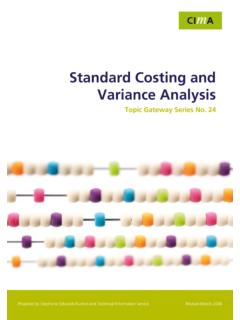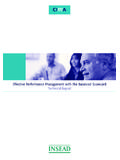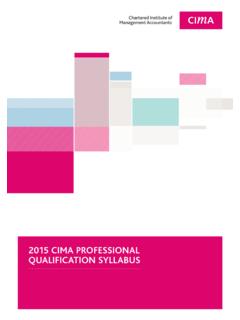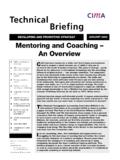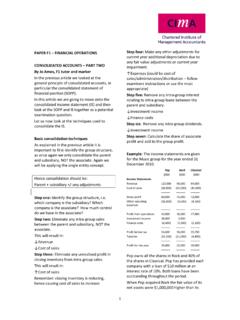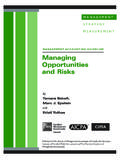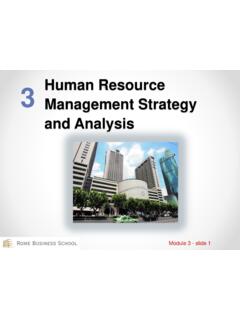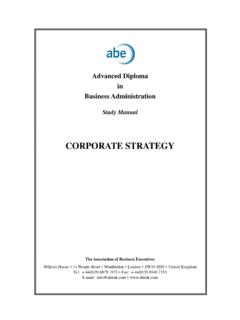Transcription of Customer Profitability Analysis - CIMA
1 CustomerProfitabilityAnalysisByMarc J. EpsteinMANAGEMENT ACCOUNTING GUIDELINEP ublished by The Society of Management Accountants of Canada, the AmericanInstitute of Certified Public Accountants and The Chartered Institute ofManagement 2000 by The Society of Management Accountants of Canada (CMA Canada), the American Institute of CertifiedPublic Accountants, Inc. (AICPA) and The Chartered Institute of Management Accountants (CIMA). All Rights part of this publication may be reproduced, stored in a retrieval system or transmitted, in any form or by any means, withoutthe prior written consent of the publisher or a licence from The Canadian Copyright Licensing Agency (Access Copyright).For an Access Copyright Licence, visit or call toll free to : 1-55302-141-XNOTICE TO READERSThe material contained in the Management Accounting Guideline Customer Profitability Analysis is designed to provide illustrativeinformation with respect to the subject matter covered.
2 It does not establish standards or preferred material hasnot been considered or acted upon by any senior or technical committees or the board of directors of either the AICPA, CIMAor The Society of Management Accountants of Canada and does not represent an official opinion or position of either theAICPA, CIMA or The Society of Management Accountants of EXECUTIVE SUMMARYCUSTOMER Profitability ANALYSISINTRODUCTIONIn Charlotte, North Carolina, the cus-tomer service center of First UnionCorporation, the sixth largest bank inthe United States, handles 45 millioncalls per year. The center s computersystem, Einstein , determines the rank-ing of a Customer profitable or unprof-itable in 15 seconds.
3 Customers areassessed with respect to minimum bal-ance, account activity, branch visits,and other variables. At the service desk,the computer screen displays a color red, green, or yellow to signify thecustomer s Profitability rating. Thus,when a Customer requests a lower creditcard interest rate or a waiver of accountservice fees, the service representativeINTRODUCTION3 ANALYZING Customer PROFITABILITY13 IMPROVING Customer PROFITABILITY23 CONCLUSION27 ENDNOTES28 BIBLIOGRAPHY29 Strategic cost management and activity-basedcosting have caused companies to look moreclosely at the drivers of their costs. Increasingly,companies have been focusing on the causes ofcosts and profits to enable better managementof those costs and profits.
4 First, companies focusedon product Profitability and more recently oncustomer recognize that though exceedingcustomer expectations is a worthy goal, exceed-ing those expectations profitably is necessary forlong-term corporate viability. Thus, an under-standing of corporate Profitability necessarilyrelies on an understanding of what drives share-holder value in organizations. Increasingly,companies are focusing on the relationshipsbetween employee satisfaction, Customer satis-faction, and corporate Profitability . They arefocusing on the drivers of corporate profitabilityand this requires an understanding of how toincrease Customer revenues and how to decreasecustomer costs. This management accountingguideline provides a discussion with examplesof both the Analysis of Customer costs throughactivity-based costing and the development oflong-term Customer relationships for increasedrevenues and profits through the measurementof Customer able to respond quickly accordingto the customers company can outperform rivals only ifit can establish a difference that it canpreserve.
5 It must deliver greater value tocustomers or create comparable value ata lower cost, or do E. Porter. 1996. What is strategy ? Harvard Business Review(November-December).First Union recognizes that not allcustomers are the same. Though cus-tomer satisfaction is important, thegoal is to increase Customer and cor-porate Profitability . Customer prof - itability Analysis is evolving as a basisfor determining the level of service STRATEGY3that customers receive and the level of theirfees. First Union estimates that its Einstein system will add at least $100 million to itsannual revenue. About half of that willcome from extra fees and other revenuefrom unprofitable customers, while therest will flow from pampering preferredcustomers who might otherwise leave thebank.
6 First Union is not alone in this effort;an increasing number of companies employthe same procedures to determine profitableand unprofitable customers and managecustomer relationships to improve example above is one of many thatdemonstrate the increased corporate focuson customers and their Profitability . Thisguideline presents a discussion of the stateof the art and of best practices in determin-ing Customer Profitability with respect to: understanding and analyzing customerprofitability. maintaining and increasing customerprofitability. turning unprofitable customers intoprofitable guideline does not present a detailedexamination of an all-inclusive analyticaltool for determining Customer does, however, provide the tools thatpermit the Analysis of Customer profitabilityand the implementation of programs toimprove these the last ten years, strategic costmanagement and activity-based costing(ABC) have created a framework for com-panies to more closely examine the drivers(or causes) of their costs in order to improvemanagement decisions and corporate prof - itability .
7 Companies initially focused onproduct Profitability are now using ABCand other models to further examine theprofitability of distribution channels andcustomers. Simultaneously, many companiesare exploring the drivers of profit and suc-cess through the use of the balanced score-card. Whichever model is used initially,determining Customer Profitability requiresa clearer understanding of the causes ofthe revenues and the costs. This guidelineprovides details of company experiences inexamining the causal relationships betweenthe drivers of Customer satisfaction andcustomer revenues as well as in measuringthe Profitability and costs of servicingexisting customers. Comprehensive systemsthat identify, measure, analyze and managecustomer Profitability and its drivers areonly now being developed (Epstein,Kumar, and Westbrook 1999).
8 Expanding global competition is onereason behind the increased concern forcustomer Profitability . Companies world-wide are being pressured to become morecustomer focused and to increase share-holder value. Customer Profitability analysisis a useful tool in both areas. Increasing Customer FocusMany companies are convinced thatimproving corporate Profitability requiresmore Customer contact and closer customerrelationships. Further, many marketingprofessionals have directed recent attentionto increasing Customer satisfaction, primar-ily examining the links between overallsatisfaction and revenues. Meanwhile,accountants have traditionally focused oncost reduction. Customer profitabilityanalysis attempts to bring together market-ing and accounting professionals to analyze,manage, and improve Customer are attempting to betterunderstand and satisfy present and futurecustomer demands.
9 However, the goal is toincrease Customer satisfaction Analysis presented here, relying on ABCand other tools, can direct managerialattention to areas of improvement thatcan lead to greater Customer and corporateprofits. An ABC system is not the onlymeans to measure Customer Profitability ,but merely one of several tools that can ABC provides a better understand-ing of the Profitability of products and services, companies have started to use thesame approach to understand the profitabil-ity of customers. Following an ABC Analysis ,companies can examine the Customer profit-ability information and determine how tomanage Customer relationships in order toincrease Customer satisfaction and theprofitability of both individual customersand Customer segments.
10 The ABC analysisoften provides information leading to suchimproved relationships that the profitabilityof both the company and its customers have been using improvedinformation technology and large databasesto help refine marketing efforts. Marketingtools and IT systems now permit companiesto target individual customers and customergroups with pinpoint accuracy and to4 MANAGEMENTSTRATEGYMEASUREMENT determine whether or not a Customer spendsenough to warrant the marketing effort. AtFederal Express, for example, customers whospend a lot of money but demand little cus-tomer service and marketing investment aretreated differently than those who spendjust as much but cost more to maintain. Inaddition, the company no longer marketsaggressively to those customers who spendlittle and show few signs of spending morein the future.
